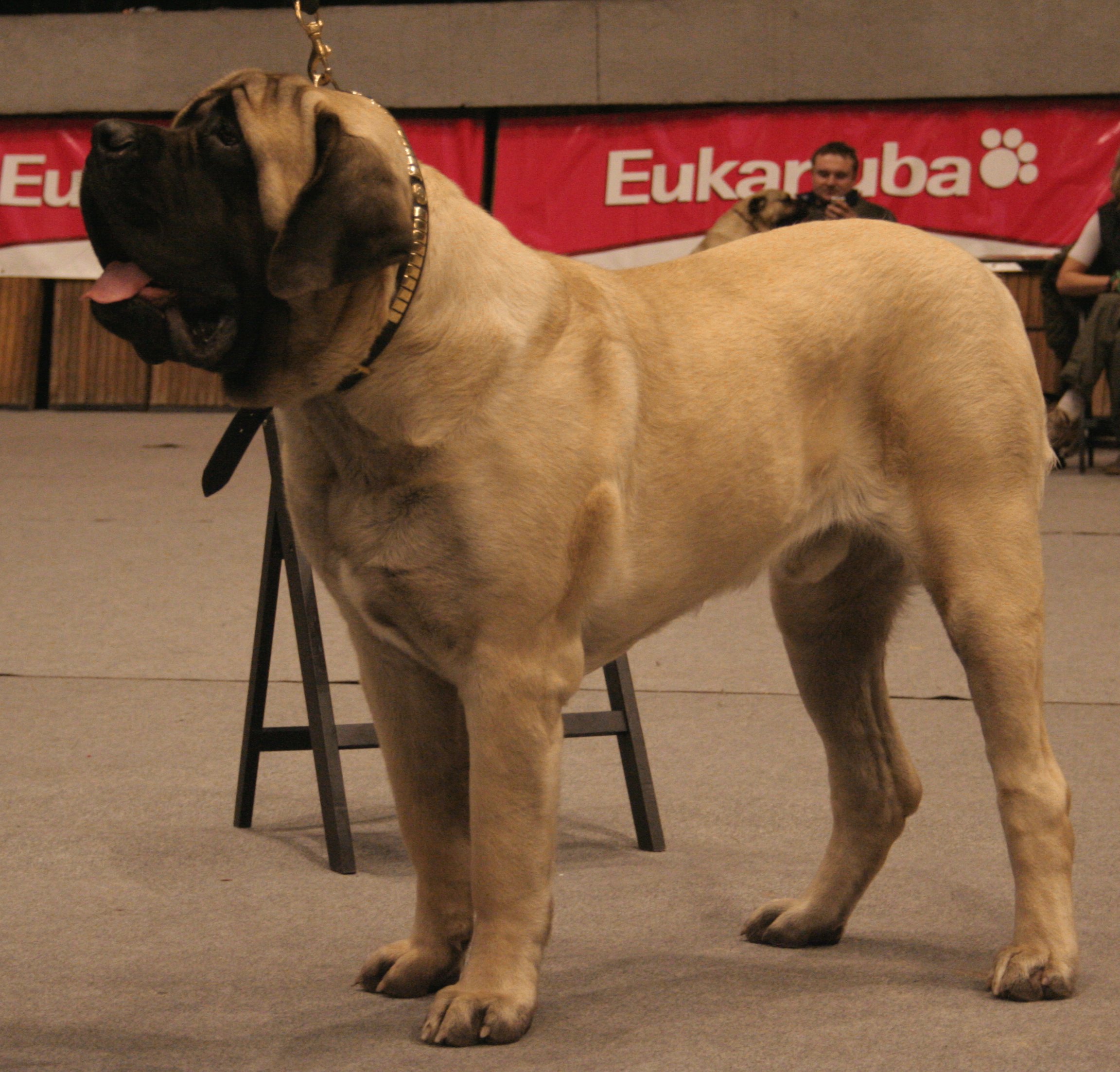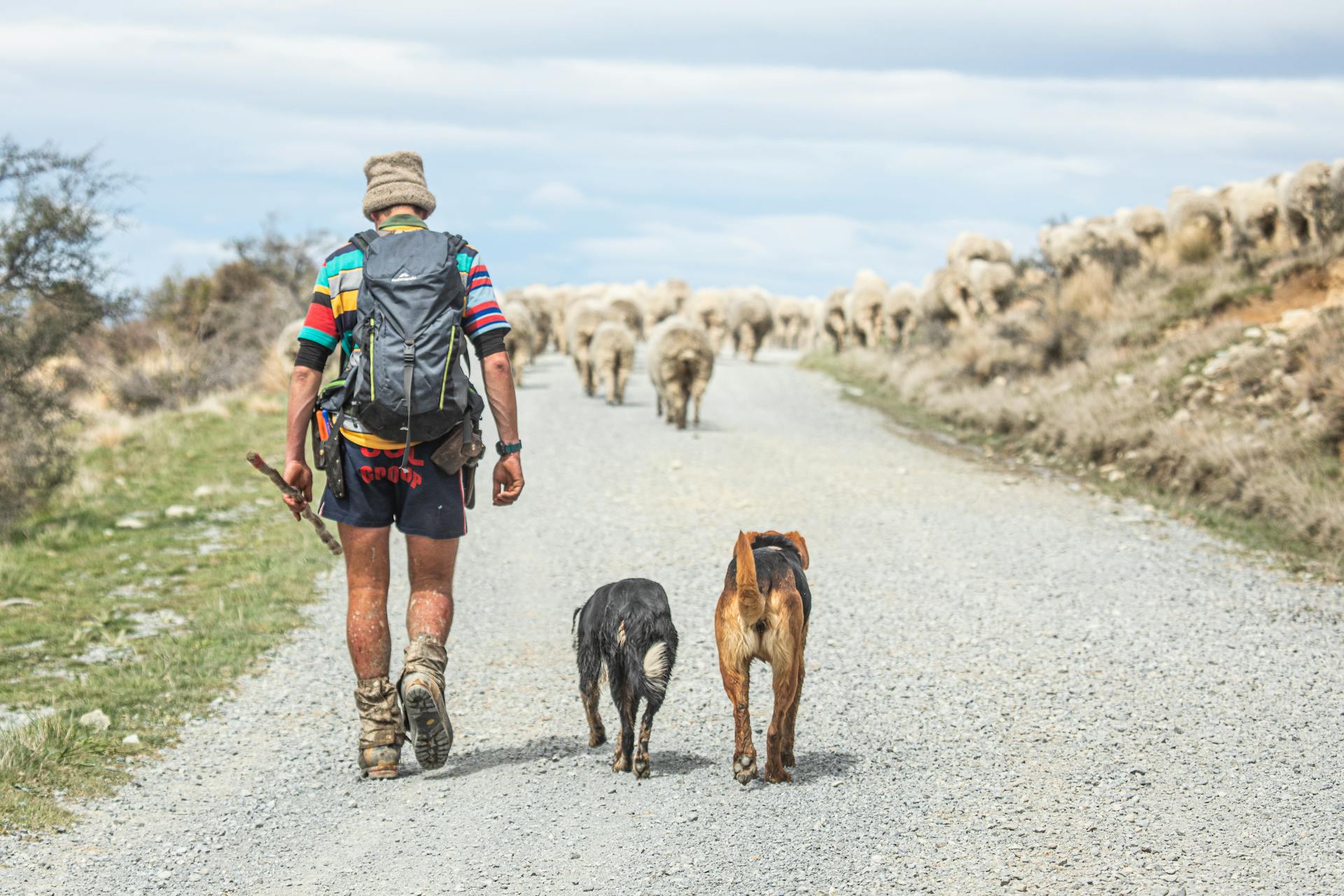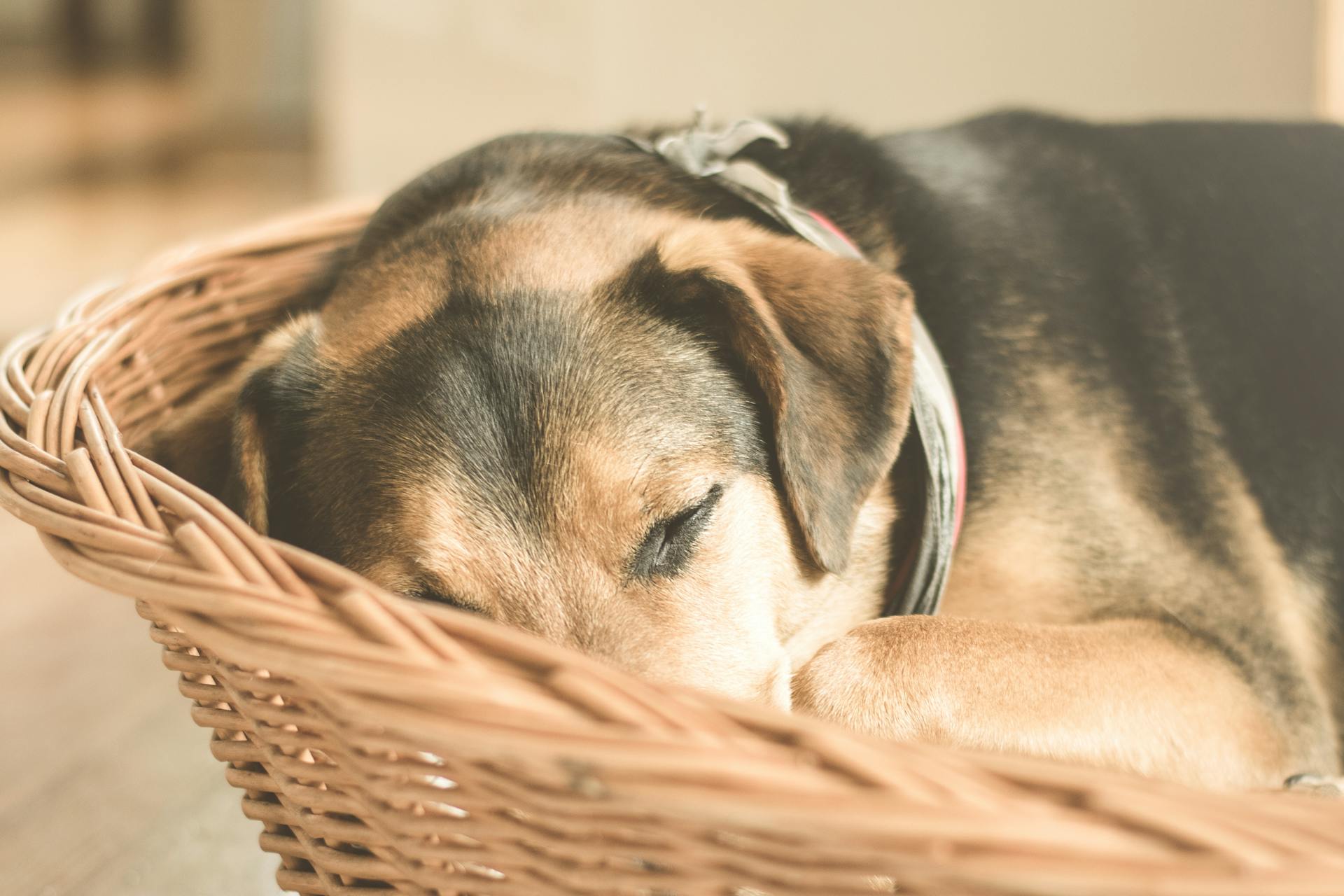
The English Mastiff is an ancient breed with a rich history dating back to the Roman Empire. They were first bred as guard dogs and war dogs.
Their massive size and intimidating appearance made them a formidable presence on the battlefield. Originally weighing up to 230 pounds, they were a force to be reckoned with.
Despite their intimidating reputation, English Mastiffs are known for their gentle and calm nature, making them a great companion for families. They are often described as "laid-back" and easy-going.
Their calm demeanor is a result of their breeding history, which emphasized loyalty and protection over aggression and ferocity.
A unique perspective: History of Mastiff Dogs
Caring for English Mastiffs
English Mastiffs are generally lazy and don't require a lot of exercise, but they can be wary of strangers and need early socialization to prevent protective behaviors.
Their short, dense coats are relatively easy to brush and only need to be bathed every few months, but they do shed moderately and may need more frequent brushing during heavy shedding periods.
Mastiffs are excessive droolers, so it's essential to keep a rag handy for quick cleanups.
They need lots of room to exist comfortably, so a spacious home is a must, and their big appetite comes with a significant cost, so budget accordingly.
Well-trained and well-socialized Mastiffs are gentle giants and do well with other animals and children, but their giant size can be problematic for smaller animals and young children.
Regular brushing can help reduce shedding, but it's not a foolproof solution, and Mastiffs may still experience periods of heavy shedding.
You might like: Dogs Similar to Bullmastiff
Health and Wellness
English Mastiffs are prone to certain health issues, which can be mitigated with proper care and attention. One of the most significant concerns is their relatively short lifespan, ranging from 6 to 10 years.
Regular veterinary check-ups are crucial in detecting potential health issues early on. This includes monitoring for conditions like hip dysplasia, which can cause pain and mobility issues, and heart disease, which can lead to heart murmurs and other complications.
To help prevent bloat, a life-threatening condition that can affect large breeds like English Mastiffs, it's essential to feed smaller, more frequent meals and avoid vigorous exercise after eating. A slow feeder bowl can also help reduce the risk of bloat.
Here are some common health concerns in English Mastiffs, along with some practical tips for prevention and management:
- Hip Dysplasia: Regular exercise and maintaining a healthy weight can help mitigate the impact of hip dysplasia.
- Bloat (GDV): Feeding smaller, more frequent meals and avoiding vigorous exercise after eating can help reduce the risk of bloat.
- Heart Disease: Regular veterinary check-ups and a heart-healthy diet can contribute to their cardiac well-being.
- Eye Conditions: Regular eye exams can help detect and manage conditions like progressive retinal atrophy (PRA) and cataracts.
Nutritional Tips
Mastiffs have specific nutritional needs to maintain their joint health. For dogs with growth disorders like hip dysplasia, glucosamine and chondroitin supplements can be beneficial.
These supplements help keep their joints healthy by reducing inflammation and promoting cartilage growth. Omega-3 supplements also aid in joint health and keep their skin and coat healthy.
It's essential to consider the cost of food when bringing home a Mastiff puppy, as they require much more food than smaller breeds. A big dog like a Mastiff can cost a significant amount to feed.
Mastiffs need a lot of room to exist comfortably, which means owners should consider the space they have available before bringing one home.
Readers also liked: German Shorthaired Pointer Free to Good Home
Ear Care
Taking good care of your Mastiff's ears is crucial for their overall health. Their ears need regular cleaning with a veterinary-approved ear cleanser.
After a bath or a swim, their ears must be cleaned to prevent infections. This is especially important if they've been in the water.
Cleaning their ears regularly will help keep their ear canals healthy.
Health
Mastiffs are prone to certain health issues, and it's essential to be aware of them to ensure your furry friend lives a happy and healthy life. A Mastiff's lifespan is typically between 6 to 10 years, which is shorter than that of small-breed dogs.
Hip and elbow dysplasia are common conditions that can cause pain and lameness in Mastiffs. These conditions can be genetic and occur when the joints form abnormally.
Progressive retinal atrophy (PRA) is a degenerative eye disease that can lead to blindness. While there's no cure for PRA, Mastiffs can adapt to the vision loss and maintain a good quality of life.
Additional reading: Average Age for Boston Terrier
Heart disease is another concern for Mastiffs, with conditions such as heart valve issues and dilated cardiomyopathy (DCM) being possible. A heart murmur is often one of the first signs, and a veterinary cardiologist may need to perform an echocardiogram to determine the exact cause.
Bloat or gastric dilatation-volvulus (GDV) is a life-threatening condition that can occur in large breeds like Mastiffs. Feeding smaller, more frequent meals and avoiding vigorous exercise after eating can help reduce the risk.
Epilepsy is a seizure disorder that can affect Mastiffs, typically beginning between 6 months and 5 years of age. Treatment is often daily oral medication.
Here are some common health issues to be aware of in Mastiffs:
- Hip dysplasia
- Gastric dilatation-volvulus (GDV) or bloat
- Cardiac issues, such as dilated cardiomyopathy (DCM)
- Progressive retinal atrophy (PRA)
- Epilepsy
To help prevent or manage these health issues, it's essential to provide regular veterinary care, a balanced diet, and controlled exercise. This can help ensure your Mastiff lives a long and happy life.
Training and Behavior
English Mastiffs are gentle giants, but they can be wary of strangers due to their instinctual guarding nature. They don't bark much, but early training and socialization are crucial to help them feel comfortable around new people.
Training sessions should be short and fun, using positive reinforcement methods like treats and praise. This breed responds well to eye contact and body language, so be sure to hold their gaze and wear a smile while teaching commands.
To keep your English Mastiff engaged, keep training sessions to 15 minutes or less, and use a variety of rewards to keep them motivated. With patience and consistency, you'll have a well-behaved companion in no time.
Here are some key training tips to keep in mind:
- Use positive reinforcement techniques like treats, praise, and interactive dog toys.
- Teach essential commands like sit, stay, come, and leash manners.
- Expose your Mastiff puppy to various people, dogs, and environments from a young age.
- Keep leash training in mind, given their size and strength.
Behavior
Mastiffs can be instinctually wary of strangers, so early training and socialization are crucial.
They don't bark a lot, and are gentle with humans and animals they know, making them a great addition to many families.
Mastiffs are eager to please and learn quickly, but training sessions should be kept short to keep their attention and focus.
Positive reinforcement methods are ideal for training Mastiffs, as they respond well to treats, praise, and interactive dog toys.
Recommended read: Are Great Danes Mastiffs
With patience and consistency, you can teach your Mastiff essential commands like sit, stay, come, and leash manners.
To harness their strength and intelligence, use positive reinforcement techniques, early socialization, and gentle handling.
Here's a summary of the key traits to keep in mind when training a Mastiff:
Remember, with experience and patience, you can develop a strong bond with your Mastiff and enjoy a rewarding training experience.
Boerboel
The Boerboel is a powerful breed that requires careful consideration before bringing one home. They can weigh anywhere from 150 to 200 pounds.
Their size and strength make them a formidable presence, but it's essential to remember that they're not a breed for beginners. Prior experience owning large breeds is recommended before adopting a Boerboel.
In their native South Africa, Boerboels are known to fend off fierce predators like leopards, which requires a strong and confident temperament.
Consider reading: Boerboel Ridgeback Mix
Exercise and Environment
English Mastiffs are built for comfort, not speed. They don't require big, adventurous outings, but rather gentle exercise to keep them happy and healthy.

A daily walk of a mile or two at a slower pace is perfect for this breed, with a recommended 20 to 30 minutes at a time. You can also try low-impact exercises like swimming, which is beneficial for their joints.
Grassy surfaces are ideal for walking your Mastiff, as they're easier on their joints than pavement. If you have access to a pond or pool, swimming is a great way to get them moving without putting too much strain on their bodies.
As a puppy, it's essential to keep exercise low-key to avoid damaging their growth plates. A short walk of half a block is a good starting point. Don't worry if they seem lazy – it's just their nature.
A home with a pool or lake access is ideal for English Mastiffs, as they love water and it's low-impact exercise for their joints. If you don't have a pool, a nearby park or dog run is a great alternative.
Remember, gentle exercise is key for English Mastiffs, especially when they're young. A daily walk and some playtime should keep them happy and healthy.
History and Origins
The English Mastiff has a proud ancient lineage, with dogs known as mastiffs thriving for millennia in Greece, Rome, China, and Egypt. In fact, hieroglyphics of Mastiff likenesses show up on monuments in the Nile region as early as 3000 BC.
Mastiffs were bred for guarding, hunting, and companionship, and were often used as war dogs who fought invaders on many fronts. They even caught the attention of Caesar himself when he ventured onto Britain's shores in 55 BC.
Today, the English Mastiff is one of the first recognized breeds in the American Kennel Club, joining the ranks in 1885. With a rich history intertwined with human civilization, it's no wonder this breed has left an indelible mark on the world of canines.
Recommended read: Shiba Inu Bc
Historical Origins and Legacy
The English Mastiff has a rich history that spans thousands of years, with evidence of mastiff-like dogs appearing in ancient civilizations such as Greece, Rome, China, and Egypt as far back as 3000 BC.

These dogs were highly valued for their strength, loyalty, and protective instincts, making them ideal for guarding, hunting, and companionship.
Mastiffs were even used as war dogs, fighting alongside their human companions on many fronts, including a notable campaign against the French in 1415.
By the late 1800s, Mastiffs had made their way to the United States, where they were used to guard plantations and eventually became one of the first recognized breeds in the American Kennel Club in 1885.
After World War II, the breed nearly disappeared, but thanks to dedicated breeders, it was brought back from the brink and is now a beloved companion animal.
Today, Mastiffs can be found in homes around the world, where they are cherished for their loyalty and gentle nature.
Here's an interesting read: Tibetan Mastiff Biggest Dog in the World
Neapolitan
The Neapolitan Mastiff is a massive breed, weighing in at 110 to 150 pounds.
Their size is not the only impressive feature, as they can grow up to 24 to 31 inches tall.
These dogs are known for their protective nature, making them a great choice for experienced owners who want a loyal companion.
However, their droopy face and tendency to drool may require some extra care and cleaning.
Physical Characteristics
The English Mastiff is an impressive breed, and its physical characteristics are a big part of what makes it so majestic.
They come in a range of coat colors, including fawn, apricot, and brindle, which adds to their regal appearance.
One of the most striking features of the English Mastiff is its massive build, which is one of the largest dog breeds in the world.
Their head is broad and square, with a short, dark muzzle and expressive eyes that reflect their gentle nature.
English Mastiffs have a muscular frame, with a strong and sturdy body that's perfect for their impressive size.
Their coat is short and smooth, which makes it easy to care for, and it comes in a variety of colors to suit any owner's taste.
Their tail is long and tapers to a fine point, adding to the breed's elegance and overall balance.
Here's a breakdown of the English Mastiff's physical characteristics:
- Coat colors: fawn, apricot, and brindle
- Head shape: broad and square
- Muzzle color: short, dark
- Eyes: expressive, wide-set, and brown
- Frame: muscular, strong, and sturdy
- Tail: long, tapers to a fine point
Temperament and Suitability
English Mastiffs are known for their gentle and affectionate nature, making them wonderful companions for families. They're patient and tolerant, especially with children, and assume the role of a gentle and watchful friend.
Their protective instincts make them excellent guardians, but they're not naturally aggressive. They'll watch over their family and home, but they're not prone to barking and biting.
Despite their size, English Mastiffs are calm and relaxed, making them well-suited for indoor living. They're content to spend time indoors with their loved ones and don't require a lot of exercise.
Their calm and gentle nature makes them suitable for families with children who understand how to interact with dogs. However, it's essential to consider the size and strength of the Mastiff, as they may accidentally bump into younger children.
English Mastiffs are loyal and devoted companions, forming strong bonds with their family members. They thrive on close companionship and are often described as "gentle giants."
Expand your knowledge: Gentle Giant Dog Breeds
Here are some key characteristics of English Mastiffs:
- Gentle and affectionate
- Protective instincts
- Loyal and devoted
- Calm and relaxed
- Excellent with children
While they're generally easy-going, English Mastiffs may remain wary of strangers and other pets. However, with early and consistent training, they can learn to get along with other animals.
Their calm and gentle nature makes them wonderful emotional support animals, providing a soothing presence for those in need.
Care and Maintenance
English Mastiffs are generally low-maintenance when it comes to grooming, with short, dense coats that shed moderately. Weekly brushing can reduce shedding, but bathing is only necessary every few months.
Mastiffs do require regular care to prevent health issues, such as gastric dilatation and volvulus (GDV) or bloat. To prevent this, feed them 2-3 meals per day instead of one big meal, and avoid exercise around mealtimes.
Here are some essential care tasks to keep in mind:
Regular care and attention will help keep your English Mastiff happy and healthy.
Feeding Large Breed Dogs
Feeding large breed dogs like English Mastiffs requires careful consideration. They need a lot of food due to their massive size, so budget accordingly.
Mastiffs do well on a dog food approved by the Association of American Feed Control Officials (AAFCO) and formulated for large breeds. This is a general guideline, but it's best to discuss your dog's diet with your veterinarian, as they can make recommendations based on your pup's specific medical history.
Feeding your Mastiff 2-3 meals per day, instead of one big meal, can help prevent gastric dilatation and volvulus (GDV) or bloat. This is a crucial habit to develop, especially for deep-chested dogs like Mastiffs.
Mastiffs require a specific ratio of calcium to phosphorus in their food to prevent skeletal disorders. Protein content is also a consideration, aiming for no more than 26 percent protein in your dog's adult food blend.
Here are some general guidelines to keep in mind when feeding your large breed dog:
It's essential to choose a high-quality commercial large-breed dog food that provides complete and balanced nutrition for your Mastiff. Always consider your dog's age and choose a formula that fits their stage in life.
Grooming Guide
Grooming your English Mastiff is relatively low-maintenance, thanks to their short, dense coat.
They are moderate shedders, so weekly brushing can help reduce shedding, but bathing is only necessary every few months.
However, be prepared for excessive drooling, which requires having a rag handy for quick cleanups.
Brushing your Mastiff every few days is a good rule of thumb, and daily brushing is even better for removing dead hair and keeping them looking sharp.
Use a grooming mitt or a bristle brush, and a bath is only needed every four to six weeks.
Don't forget to brush your Mastiff's teeth daily to keep them shiny and plaque-free, starting with a few times a week and working your way up.
Trim their nails once a month, and check their ears for debris, redness, swelling, or mites a few times a week.
If you notice any signs of ear mites, such as dark debris or your pup shaking their head, speak to your vet for guidance.
Take a look at this: 8 Week Old Yorkshire Terrier Puppy
Frequently Asked Questions
Is English Mastiff the strongest dog?
English Mastiffs have impressive bite strength, measuring 556 psi, making them a strong contender among dog breeds. Their size and strength make them a formidable force, but is their bite as powerful as their reputation suggests?
Which is bigger English Mastiff or Bullmastiff?
The English Mastiff is generally larger than the Bullmastiff, with a more massive size and powerful build.
Is an English Mastiff bigger than a Cane Corso?
No, a Cane Corso is generally smaller than an English Mastiff, standing 24-28 inches tall and weighing 90-130 pounds, compared to the Mastiff's larger size.
Featured Images: pexels.com


